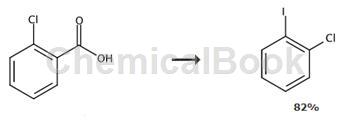Background and overview[1][2]
1-Chloro-2-iodobenzene is an organic intermediate, which can be obtained by chlorination of iodobenzene or iodination of chlorobenzene.
Preparation[1-2]

Method 1,
General/Typical Procedure: Typical procedure for halogenation. BF3-H2O (4 mL) was added to the mixture of deactivated aromatic compound (10 mmol) and N-halosuccinimide (10 mmol) in a 30 mL Nalgene bottle. Close the bottle and stir the mixture at the desired temperature (room temperature for most reactions) for the specified time. For higher temperature reactions, pressure tubes are used. The progress of the reaction was monitored by GC/MS analysis. Then completely transfer the reaction mixture to a separatory funnel using water (30 mL) and dichloromethane (2 × 30 mL) and shake well to extract the product into the organic layer. Wash the organic layer with saturated sodium bisulfite or sodium thiosulfate (15 mL) solution to remove any free halogen present, then add saturated sodium bicarbonate solution (30 mL) and brine (30 mL). Then wash with water (2 × 30 mL) and dry over anhydrous sodium sulfate. The solvent was removed under reduced pressure and the product was purified by fractional distillation or recrystallization from petroleum ether. Compound-5B. The yield is 77%.
Method 2,

Reflow a mixture of Ar-COOH (1 mmol), N-iodoamide (1.5-4 equivalents) and solvent (4 mL) under irradiation with a 500W tungsten lamp (TL) or under fluorescent chamber lighting (FL). 2-Chloroiodobenzene, yield 82% 1HNMR δ 7.86 (dd, J = 8, 2Hz, 1H), 7.45 (dd, J = 8, 2Hz, 1H), 7.27 (m, 1H), 6.95 (m, 1H ); 13CNMRδ140.4,138.7,129.5,128.0,98.3 (C-1).
Main reference materials
[1] J. Am. Chem. Soc.2004,126,48,15770-15776
[2] From PCT Int. Appl., 2011154953, 15 Dec 201

 微信扫一扫打赏
微信扫一扫打赏

